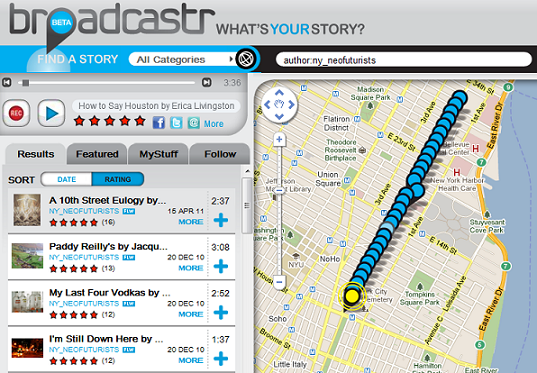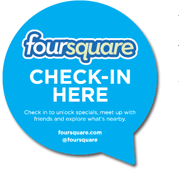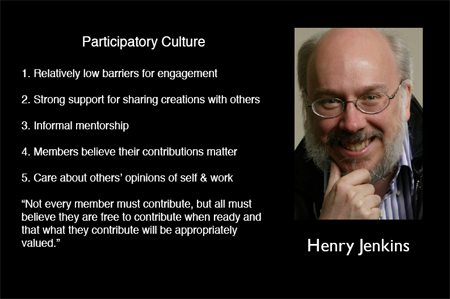Are you a Connector? Firefighter? Multitasker? Which app best boosts your productivity? Find out in a quick and easy quiz from FAST COMPANY.
The Art of Participatory Culture - Learning to Play WITH Our Audiences
This article was originally a speech for TEDxMichiganAve delivered by David Dombrosky on May 7, 2011 in Chicago, Illinois.
One of my favorite quotes comes from Confucius. He said, “Tell me, and I will forget. Show me, and I may remember. Involve me, and I will understand.” This quote has become one of my touchstones because it reminds me that: life is experiential, and the most resonant experiences in my life were ones in which I was an active participant. The first time I sang a solo for a public audience. Writing and performing a solo theatrical performance in college. Learning how to tango earlier this year.
If the arts community agrees that we want audiences to have deeply resonant experiences with the arts, then the question arises, “How can artists and arts organizations go beyond telling their audiences about the work or showing the work to patrons and actually INVOLVE them in the work?”
Technological advances over the past decade have propelled us into a highly participatory culture, wherein individuals no longer simply consume culture, but they now actively produce and contribute to culture. In 2006, media scholar Henry Jenkins and his colleagues published a white paper entitled Confronting the Challenges of a Participatory Culture in which they described five defining elements for participatory culture.
With this article, I would like to address the question of how artists and arts organizations can involve audiences in their work by highlighting how a number of artists and organizations exemplify the defining elements of participatory culture.
#1 – “A participatory culture has relatively low barriers to artistic expression and civic engagement.”
We see evidence of this every day. The number of free web tools and mobile apps that have been released over the past decade is astronomical. With each successive release, the barrier to artistic expression and engagement is lowered that much more.
One recently released, free tool called Broadcastr allows people to record 3-minute audio segments and pin them to specific locations on a map that is available on their website as well as through their mobile application.

Many of you may know the Neo-Futurists, a theatre performance group originally established here in Chicago. Their New York City chapter has a show called Too Much Light Makes the Baby Go Blind which contains 30 plays performed in 60 minutes. Earlier this year, they used Broadcastr to create 30 plays in 30 blocks. So if you go to Second Avenue in Manhattan, you can walk from Houston Street to 29th Street and experience 30 location-specific, interactive pieces of audio content. Some of them direct you to do things, some of them are little songs, some of them are plays with multiple voices, and some of them reference their locations very directly.
The technology required to do this? Either a computer with speakers and a microphone OR a smartphone. That’s it.
#2 - A participatory culture has strong support for creating and sharing one’s creations with others
Over the past two years, choral composer Eric Whitacre has worked with singers from around the world to create “virtual choirs” for the performance of his compositions. Participating singers download a PDF version of the sheet music for their vocal part. They watch a YouTube video of Whitacre conducting the music, record their vocal tracks, then send the tracks to Whitacre for final editing. Whitacre and his producer then combine all of the vocal tracks together into a single audio composition and syncs it with a video featuring a virtual riser with the floating faces of each of the singers performing the piece.
His most recent virtual choir composition entitled “Sleep” features 2052 singers from 58 different countries. As of today, the video has been viewed nearly 500,000 times on YouTube. His 2009 virtual choir composition “Lux Aurumque” has had over 2.4 million views.
#3 - A participatory culture has some type of informal mentorship whereby what is known by the most experienced is passed along to novices
One organization which exemplifies this element is the San Francisco Symphony. With their Community of Music Makers program, the symphony serves amateur adult musicians and promotes active participation in music-making and lifelong learning. Community of Music Makers includes workshops and events for amateur vocalists and instrumentalists in symphony’s performance hall, where participants are able to improve their skills. They also receive live and online coaching sessions from the symphony’s musicians and artistic staff. A chamber music convening service serves as a clearinghouse to help individual players and ensembles connect each other and identify performance opportunities in the local community.
The lesson here? Learn to love amateurs as they are likely to be a strong core from which to further develop your audience.
#4 – In a participatory culture, members believe that their contributions matter.
The Brooklyn Museum pioneered crowd-curation in 2008 with its photography exhibition Click! First launched through an open call for artists to submit photos related to the theme of “The Changing Faces of Brooklyn,” the artwork was then made available online for anyone to curate. This year, they are taking another spin on this concept with the exhibition Split Second: Indian Paintings, which invited the Brooklyn Museum’s online community to participate in a project that will result in a small installation of Indian paintings from the Museum’s permanent collection in July 2011.
The first stage of the project explores split-second reactions: in a timed trial, participants were asked to select which painting they prefer from a randomly generated pair of images. Next, participants were asked to write in their own words about a painting before rating its appeal on a scale. In the final stage, participants were asked to rate a work of art after being given unlimited time to view it alongside typical interpretive text. Each part of the exercise aims to examine how a different type of information—or a lack thereof—might affect a person's reaction to a work of art.
Once the exhibit opens in July 2011, visitors will be able to view a small selection of the paintings that generated the most controversial and dynamic responses during the evaluation process, accompanied by a visualization and analysis of the data collected.
With both of these experiments from the museum, the online participants had a clear understanding of how their contributions would matter to the overall project.
In April of this year, choreographer Jonah Boaker debuted FILTER at the Ferst Center for the Performing Arts at Georgia Tech University in Atlanta. FILTER explores how the audience can serve as a collaborative filter for the performance through the use of a mobile application.
Boaker worked closely with students from the university’s Music Technology Program to develop MassMobile, a smartphone app that acts as an interactive platform for audience members to participate by affecting the stage in different ways. Boaker’s approach to participation actually allows the audience to co-create the artistic experience in real-time.
#5 - In a participatory culture, members feel some degree of social connection with one another
Okay, so my absolute favorite exemplar of this element is the MP3 Experiment created and hosted by Improv Everywhere in New York City. Begun in 2003, the concept is quite simple. Improv Everywhere puts an original mp3 file online (usually around 45 minutes long) that people download and transfer to their iPods. Participants then: synchronize their watches to a clock on the organization's website, venture out to the same public location, and blend in with the crowd. At the predetermined time, everyone presses play. Participants then carry out coordinated instructions delivered to their headphones via narrator “Steve,” and everyone around them tries to figure out what in the world is going on.
In 2010, over 3,000 people participated in a MP3 Experiment in Midtown Manhattan. The event started in retail stores and progressed to Bryant Park for the narrator’s surprise birthday. The event ended with a massive toilet-paper-mummy dance party.
The next Mp3 Experiment in New York is scheduled for July 16, 2011. Stay tuned to the Improv Everywhere site if you're in New York and wish to participate.
Something to consider about all of the artists and arts organizations that I’ve mentioned here is that they all invite the audience to play.
As an industry, we have spent so much of our time playing FOR the audience or playing TO the audience. In order for our sector to thrive in this participatory culture, we must now invest a significant amount of time and energy exploring ways to play WITH the audience.
A Guide to Mobile Marketing, Pt. 2: Check-In Platforms
In part 2 of this Mobile Marketing Series, let's examine the value of two mobile-based check-in platforms: Facebook and Foursquare. We'll take a look at how to properly set up your organization on these platforms and explore some creative ways to run check-in campaigns. Foursquare
As of December 2010, Foursquare reported over 5 million registered users worldwide. These users often use the platform to see what their friends are up to and discover nearby businesses and organizations that may interest them. Foursquare allows users to "check-in" via their mobile phones, collect points, let friends know where they are, and earn badges.

Foursquare Screenshot
Here's how to get your organization setup properly on Foursquare:
- To register with Foursqaure, visit: http://www.foursquare.com/businesses.
- Registering with Foursquare allows you to edit venue information, view analytics, activate and deactivate specials, and add employees.
- One of the most valuable benefits to registering your organization is the ability for venue owners to view real-time stats like: total daily check-ins over time, your most recent visitors, your most frequent visitors, gender breakdown of your customers, what time of day people check in and the portion of your venue's check-ins that are broadcast to Twitter and Facebook
- Bonus Tip: Just as with Google Places, your check-in campaign will be most effective if you ask customers to check-in. During the registration process, a business may request for Foursquare to mail them a free promotional sticker that invites users to check in.

Make sure to claim your FREE sticker when you register!
Facebook Places
Another popular mobile check-in platform is Facebook Places. A recent Merchant Circle survey (the largest online network of local businesses owners) suggested that Places is gaining popularity over other check-in services like Foursquare and Gowalla.

Facebook Places Screenshot
Here's how your organization can get setup in Facebook Places:
- To claim your Place, search for your business name on Facebook via the normal Search bar. If your business’s Place already exists on Facebook, click on it to visit its page. At the bottom left side of your Place there will be a link that says "Is this your business?" Click on the link and you will be directed to a claiming flow.
- By claiming your Facebook Place page, you can manage your place’s address, contact information, business hours, profile picture, admins and other settings.
- Facebook also allows you to merge this Place page with any existing Facebook Fan Pages you may have. To do this, visit a place that you have successfully claimed, and scroll to the "Merge with existing Page" link in the left side navigation menu. Click this link, and a prompt will appear to walk you through the process.
- Bonus Trip: Facebook offers a fantastic resource on offering deals after you set up a Place page.
How Arts Orgs Are Using Check-In Platforms
Here are a few examples of how arts organizations are currently using check-in platforms:
- Austin-based film and music festival South By Southwest decided to turn this process into a game. The festival's website lists what types of badges users can compete for. In addition to competing for badges, points are also awarded to users who check in at unusual places or at early hours of the morning.
- The Whitney Museum recently partnered with FourSquare on creating a custom badge. Users who unlock this badge can present their smartphones to the front desk and redeem a $5 admission to the museum. This is a great example of how organizations can offer deals to customers.
- Brooklyn Museum offers great incentives for customers who unlock the coveted 'Mayor' badge. Foursquare mayorships are awarded to customers with the most days checked into a venue over the last 60 days. If a customer is Mayor on their Target First Saturdays events, they can receive a 1st fans membership for one year. Brooklyn Museum's community page also utilizes FourSquare's API to show who has recently checked in, what badges their customers are unlocking, and who has obtained the title of 'Mayor'.
- These types of services could also be used for arts events like gallery crawls or for arts organizations to partner with local restaurants. A gallery crawl could provide a similar type of adventurous environment where users could compete for special badges and earn points based on how many organizations they check-in with during the span of the crawl.
So what about your organization? Are you registered with location-based social media sites? If so, how are you using your presence there? (Please, share your thoughts and experiences in the comments area below.)
In the upcoming parts of this series, we'll take a look at QR Codes, SMS, and mobile app creation!







